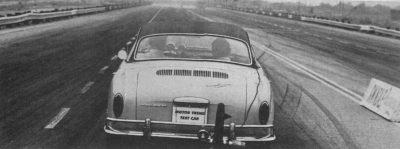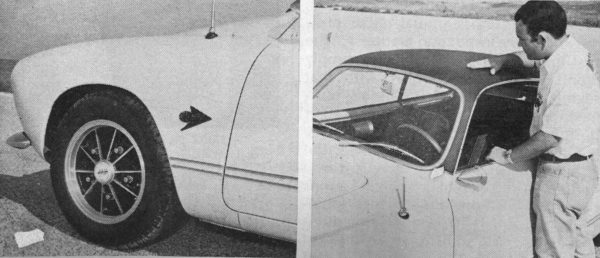|
The time
was (not so long ago,
really) when life held certain immutable truths; things in which a
person could
place his trust and faith. A Yankee victory in the World Series;
Republicans
always winning in Maine and Democrats always winning in the Solid
South; Mae
West’s bosom; Volkswagens being reliable, but slow and ugly.
So the Yankees turned into a second division club,
Re
publicans and Democrats win (or lose) elections in unaccustomed climes,
while
time, silicon, and a new generation of uninhibited starlets have turned
Miss
West into a memory. So all we had left to believe in was the ugliness
and
sluggishness of the VW Messrs. Karmann and Ghia did in the former some
years
ago, and now EMPI (for Engineered Motor Products, Inc.) have put the
kibosh on
the latter.
With all these homilies being laid
waste before our eyes, all we had left to hold on to was the laminated
wooden
steering wheel in the “Named by VW, Built by EMPI” Karmann Ghia coupe
that the
Riverside, Calif., accessory and speed equipment firm placed at our
disposal.
It felt good. Then we fired up the 1677cc engine, spurred the 105
horses,
listened to the sound in the bundle-of-snakes exhaust, and promptly
lost
interest in the Yankees, elections and Mae West. By the time we were
out of the
parking lot, we knew that this was going to be fun.
Our biggest objection to hopping up
most small engines is that torque, economy and reliability all go out
the
window in the ruthless search for power. EMPI’S chief mechanic, Dean
Lowrey,
was aware of this and very shrewdly prepared an engine that not only
preserves
these virtues, but improves them while more than doubling the 50
prancing
Prussian ponies in the stock 1300cc engine (this was a 1966 car; the
‘67s are 1500cc,
53 hp). The extra cc’s aid both low-range torque and horsepower. This
is
accomplished by using EMPI’S own 88mm cylinder barrels and forged
aluminum
pistons. The camshaft, while more radical than stock, is the tamest of
three
offered by EMPI. Known as the ECSV-440 Sport Cam, it is meant to be a
street
grind. It produces very little power below 2000 rpm,
but from there on it really snaps the needle
to the 5500 rpm red line.
|
The EMPI-Speedwell Sprint Kit with
two Stromberg
1½-inch variable-venturi carbs on special 2-piece manifolds and
the EMPI
Extractor exhaust system do a lot for inhaling and exhaling all through
the
range.
To be altogether fair, we got a
1967 standard 1500cc Ghia to drive and put it through the same paces as
the EMPI.
We knew it wouldn’t be as peppy, but
we
got several other surprises as well. Compared to the old 1192 VWs,
neither the
new VW beetle (tested in the March ‘67 MT) nor the Ghia are slugs. In
fact they
both went and handled impressively. The MEPI version was not a better
car; it
was a wholly different car. How different? Well, diet cola versus sour
mash
seems a suitable comparison. We like soft drinks, but bourbon has the
kick.
Power was less than half the story.
Handling was another chapter, and EMPI’s concern with little things
that annoy
even dedicated VW owners is the rest of the book.
Lowrey had mentioned when we took
the car that it had their camber compensator on the rear end and a sway
bar on
the front, along with heavy-duty shocks. We had already noted the
Speedwell-URM
wide-rim mag (no, not aluminum “mag,” real 90% magnesium alloy) wheels
and
Pirelli Cinturato tires (165 x 15 fronts, 185 x 15 rears) and knew they
would
help a lot too. How much all this helped we only discovered when we
drove
through the mountains just after the snow had melted.
Does this package make the car handle? Did
Errol Flynn like
girls? The slight oversteer which we found present but not excessive or
objectionable in the standard 1500 Ghia and hectic all but disappeared
in the
EMPL It would appear only if we hit a wet or sandy spot with the power
on in a
turn, but otherwise it was all gone. We were even able to induce a
slight understeer
by entering the turn well below optimum and then applying bags of power
right
at the entry to the bend and keeping it on all the way through. This
technique
also gave us optimum control at speed when entering strange turns,
giving us some clue about what the bend looked like
before we got in over our head.
|



